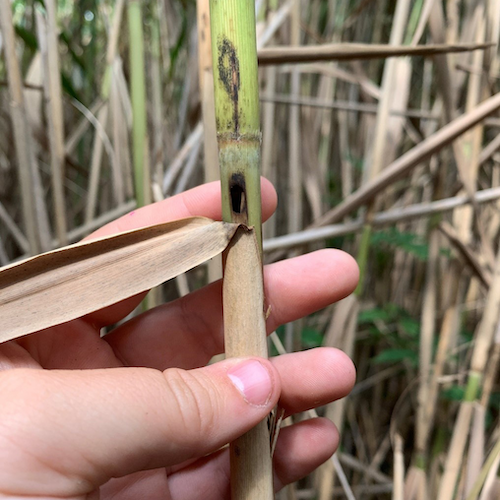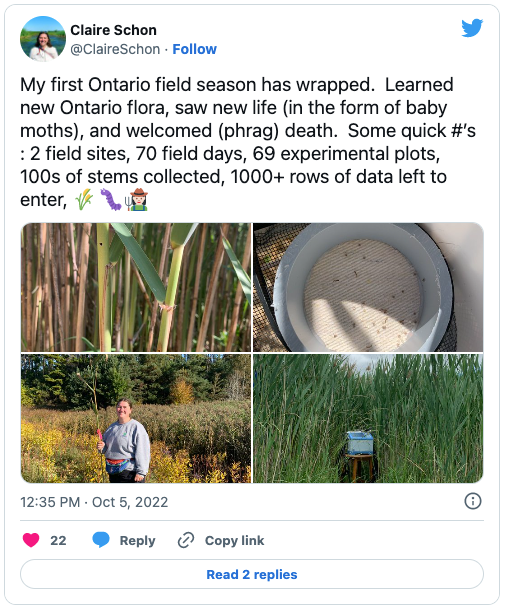Originally published by the Faculty of Science.
Waterloo biologists, in partnership with Agriculture and Agri-Food Canada and the University of Toronto, are working on a North American pilot program that uses moths as a management tool to control the invasive plant threatening Canadian wetlands.
“We’re one of the first 13 sites in North America to trial insect-based biocontrol for invasive phragmites,” says Water Institute member Dr. Rebecca Rooney. “This offers hope for chemical free invasive phragmites control.”
Phragmites, Phragmites australis, also known as European common reed is an invasive perennial grass that spreads quickly and out-competes native species for water, sunlight, and nutrients. It releases toxins from its roots into the soil to further hinder the growth of and kill surrounding plants - leading to a decrease in biodiversity and habitat.
There is no single method that is a ‘quick fix’ to manage phragmites, instead a continuous, multi-method approach is required for success and long-term results. Current removal methods include herbicides, prescribed fire, cutting underwater, flooding and physical removal.
However, two moth species - Lenisa geminipuncta and Archanara neurica - are natural enemies of the invasive plant. The goal is to use the moths as a biological control agent to help wetlands re-establish a natural balance.
"The biocontrol program for invasive Phragmites is the result of work by a large international team and has been in development for over 20 years," says Michael McTavish, a Waterloo alumus and current post doctoral fellow at the University of Toronto. "Starting with releases in 2019, AAFC and the University of Toronto have developed an operational protocol to rear, release, and monitor Phragmites biocontrol agents, and we are excited to expand the releases across southern Ontario with a growing team of collaborators."

“As larvae, these two species of moths will bore into the stem of phragmites and eat all the tissue there, which damages the plant,” says Schon. “Moth-damaged stems typically either die, or form side shoots in an effort to compensate for the feeding damage."
To investigate this, Schon is using a total of 68 testing sites at two locations - on campus and at rare Charitable Research Reserve. She is testing two different release strategies for both species of moths. She is releasing moth eggs and larvae to see which stage is more effective at damaging phragmites in our climate.
Egg cups are placed on the plant with either 60 or 120 eggs in mid to late April. The hope is for the eggs to hatch when the plant puts up new shoots. This strategy is more efficient than using moth larvae which have to be grown in the lab, placed on some stems stuck into a foam that’s placed in the middle of a patch during mid to late May.
Early results suggest the moth larva are causing damage to the phragmites plant by burrowing into the stem, killing the section of plant above where the moth larva fed. While doing her stem density and height measurements, Schon noticed the health of the plants around her.
“In early June I was very excited to find my first moth-damaged stem, it looked like it was dying and I was able to find evidence of the larva’s entrance and exit hole” said Schon. “To me, this amazing as it was the first-time I got to see evidence of my experiment working."
Around mid-July the moth matures and can fly. At this point, it will mate and lay their eggs on leaf sheaths. This is important as only the invasive phragmites keeps its leaves. Native phragmite plants drop their leaves in the late summer so the moth eggs won’t mature and can’t eat the plant in spring. This is an important distinction that allows the moths to be effective at damaging only the invasive phragmites plant.
In the late summer, Schon measured how many stems were damaged in a square metre, as well as the number of larvae entrance and exits holes. She also took plant physiology measurements including the rate of carbon assimilation, and how efficient that plant is at using water as well as measurements of plant growth and reproduction like the plant biomass, plant height, and how many seeds are produced that will be processed during the winter.

Moth-damaged phragmites stem.
Early results are promising for this new method of Phragmites control.
“We have found that moth-damaged stems are much shorter than healthy stems and rarely produce seed. Moth-damaged stems produce less biomass, and their rates of carbon assimilation are limited by the larval feeding,” explained Schon. “At our campus field site, we also found evidence that the moths had survived to adulthood.”

Next summer, she hopes to revisit the field sites and document any new moth damage from surviving eggs as well as record the changes to the plant community.